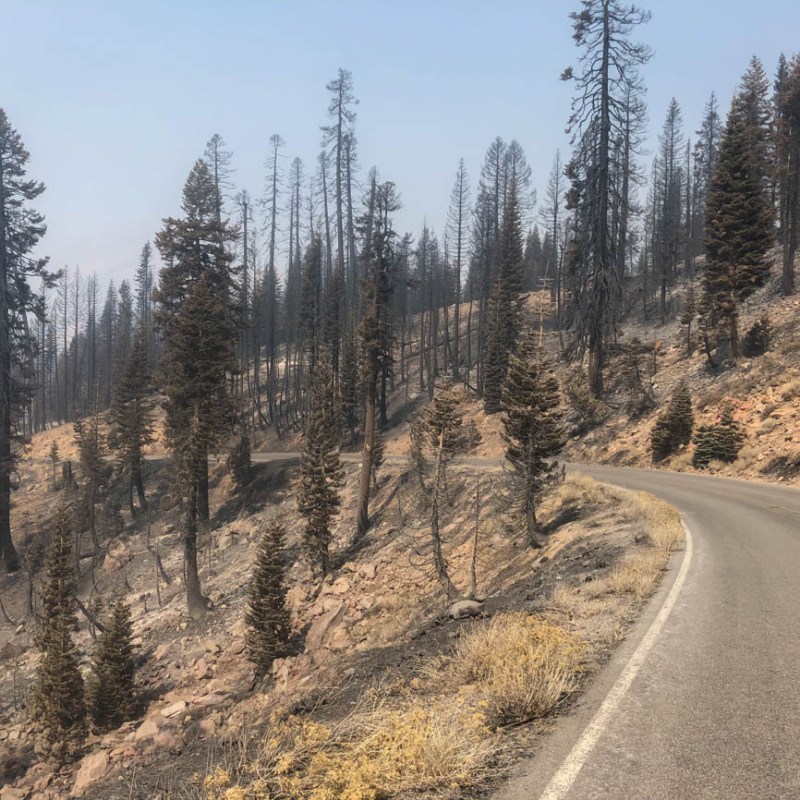
Located in northern California, Lassen Volcanic National Park is one of the most popular in the state, attracting half a million visitors annually. While lesser-known than other popular parks such as Yosemite, this 100,000-plus acre park is one of our travel experts’ favorites.
Videos by TravelAwaits
Located 130 miles north of Sacramento at the southern end of the Cascade Mountains, Lassen Volcanic National Park is known for — what else — volcanoes! It’s one of the few areas in the world where all four types of volcano — plug dome, shield, cinder cone, and strato — can be found in one place, as TravelAwaits contributor Carol Colborn notes in her article Road Trip: 5 Quaint Stops In Washington, Oregon, And California. This remote park’s eponymous volcano, Lassen Peak, last erupted in 1914, and the eruption continued for 3 years.
Home to many thermal features, including splattering mud pots, boiling springs, steaming ground, and hot sulfurous gases rising from steaming fumaroles, Lassen Volcanic National Park also features picturesque meadows and lakes, Painted Dunes, and more than 150 miles of hiking trails. Usually, it’s a spectacular spot for stargazing, however, smoke impacts air quality.
Lately, the Dixie Fire has been feasting on this northern California National Park, leaving scorched earth in place of 72,737 acres, or 68 percent of the park as of September 16th, 2021. The entire park closed until further notice.
Now the largest California wildfire this year, the Dixie Fire started on July 13, 2021, southeast of the park in Feather River Canyon. The cause of the fire is still being investigated. Currently, “the fire is burning on Plumas National Forest and Lassen National Forest, and in Lassen Volcanic National Park and in five counties: Butte, Lassen, Plumas, Shasta and Tehama,” according to the National Parks Service (NPS).
The US Interagency Wildland Fire Air Quality Response Program says that “The Dixie Fire remains at 960,581 acres (+111 acres) and is 86% contained.” You can see a map of the fire’s current spread on Google Maps. Here is the toll the fire is taking on this treasured national park.

Damaged Or Destroyed Areas Of Lassen Volcanic National Park
While the NPS engaged in preventative tactics called fuels treatment, it states that “The destroyed and damaged structures and facilities highlight the reality that fuels treatment alone cannot prevent loss from catastrophic fire.” Here’s what’s been damaged.

Warner Valley
The historic Drakesbad Guest Ranch is a beloved part of the park’s Warner Valley Area. A combination of efforts — fuel reduction, structure protection including external sprinkler systems, defensible space, and aggressive firefighting — left most structures intact.

Ultimately, much of the ranch and its and cultural landscape remains undamaged. However, two bungalow units (1-2 and 5-6), the annex building behind the dining hall, and the water treatment plant were destroyed.

At the Warner Valley Campground, 5 feet of the boardwalk near Warner Valley Trailhead burned.

Juniper Lake
Juniper Lake is a beautiful high mountain lake that features views of Lassen Peak and other surrounding peaks. Crews completed tree thinning work around Juniper Lake cabins located on the northwest shore of the lake according to NPS. Nonetheless, seven of the eight cabins were destroyed by the Dixie Fire. Only one remained unscathed.
Most of the cabins that succumbed to the fire were privately owned. However, one was owned by the federal government. According to the Lassen NPS Facebook page, the National Park Service-owned cabin “had a vital function as it accommodated crews that worked in that area of the park.” Years of fuel clearing helped spare the Juniper Lake Ranger Station.

Southwest
“Contractors and park staff removed another 300 trees from Southwest and Manzanita Lake campgrounds and reduced stand density around the Kohm Yah-mah-nee Visitor Center,” according to NPS. The Kohm Yah-mah-nee Visitor Center has been confirmed intact. However, there has been damage to the Kings Creek Falls overlook.

The Southwest Campground saw two of its three Mill Creek Falls Trail bridges destroyed, while the third was minimally burned. Kings Creek Picnic Area was reportedly minimally to moderately affected.
Park Areas Confirmed Intact Or Minimal Damage
The NPS states that “While some structures are confirmed to be damaged or destroyed, firefighters have successfully leveraged the park’s previous and current fire and fuels management projects to preserve park resources and structures.” Here is what is still intact.
Butte Lake
Back in August, winds carried the fire along the east shore of Juniper Lake, north to Snag Lake, and nearly to Butte Lake. All of the Butte Lake area, including Butte Lake Ranger Station, Butte Lake Campground, stock corral, water tank, and treatment plant, and Butte Lake Day Use Area has been confirmed intact or with minimal damage.
Summit Lake
Thanks to successful interagency firefighting, the Summit Lake area, the Summit Lake Ranger Station, and all of the structures in the Summit Lake Campground remain intact.
Years of fuels reduction bolstered the area’s wildfire resilience. Summit Lake and Southwest campgrounds had significant tree mortality due to drought, insects, and disease. Crews removed 2,000 trees, 500 of which were dead, from the Summit Lake campgrounds.

Manzanita Lake
The Manzanita Lake Area, including Loomis Museum, the ranger station, Discovery Center, campground, Camper Store, and amphitheater remain unaffected.
Full Suppression Strategy
In unified command with USFS and CAL FIRE, Lassen Volcanic National Park is implementing a full suppression strategy including retardant drops and air operations as well as the use of heavy equipment and bulldozers.
At the end of August, 3,363 personnel were working to suppress the Dixie Fire, according to NPS, including numerous park staff.

Burned Area Emergency Response (BAER) Team
As part of the post-fire response, Burned Area Emergency Response (BAER) Team began assessing the damage on September 9, 2021. The interagency team of specialists is assessing natural and cultural resources, including “recreation facilities, infrastructure, cultural resources, watershed and hydrology, fish and wildlife habitat, rare plants, and invasive species” per NPS. In addition to fire suppression damage repair and the BAER Team post-fire emergency stabilization and rehabilitation efforts, long-term fire restoration is necessary.
When Will Lassen Volcanic National Park Reopen?
At this time, there is no estimate for when the park will reopen.
The park’s superintendent, Jim Richardson, states, “We stand with our surrounding communities that have endured losses. Lassen Volcanic National Park embodies a story of resilience as life here exists on a landscape that was once covered in volcanic ash and rock. While the park remains closed, we want our visitors to know that we miss you and look forward to seeing you again when the park is able to safely increase public access.”
Related Reading:
